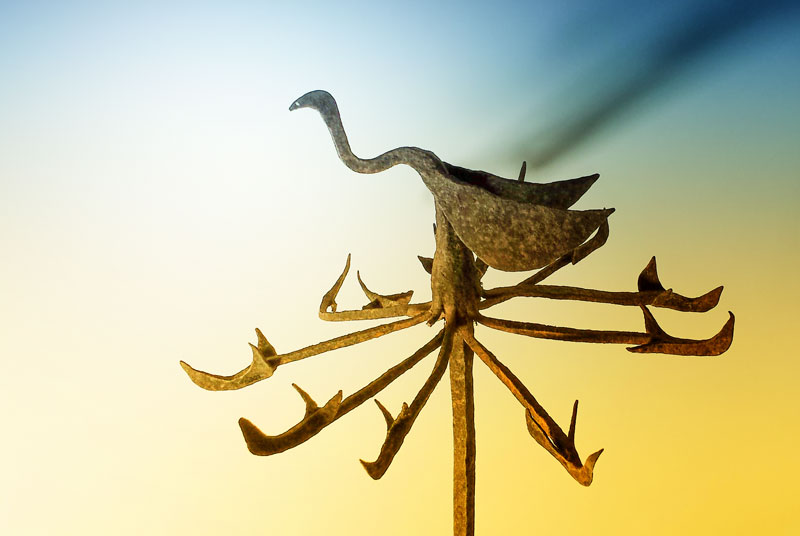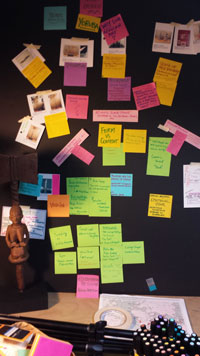 Connecting Cultures: Eyes & Ears
Connecting Cultures: Eyes & Ears
Brendan and I have been sitting across the table working on the same "project" -- connecting the dots between the traditional Yoruba culture of Africa and today's U.S. hiphop culture. We've kind of been working from either end of our brainstorming board (see photo) -- he from his love of the rapper sound and me from my fascination with vintage Yorubaland artifacts. Technically, we meet up somewhere in the dark heart of the Atlantic slave trade. But the transformations and metamorphoses that took place in that cauldron of pain seem beyond us on this day.
Brendan is researching by listening to historic rap, digging in the 1990s classics and reading texts like "Mo' Meta Blues: The World According to Questlove."
I am researching by considering the rusty iron herbalist's staff (photo above), the dance wand used by followers of the diety of thunder Sango (also pictured), divination trays aids, etc., while studying Jim's shelf of African art books.
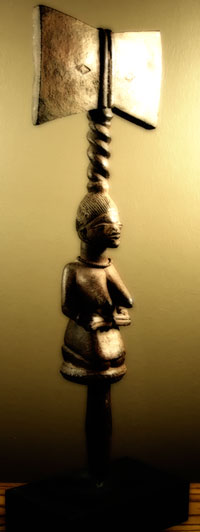 We are politely interested in each other's findings. But there is still a gap between us. Maybe instead of looking at the creators, I need to look at the fans. Us.
We are politely interested in each other's findings. But there is still a gap between us. Maybe instead of looking at the creators, I need to look at the fans. Us.
As we saw in yesterday's piece, Brendan experienced wonder through his ears -- the verbally complex storytelling of Kid Cudi woke him up to the power of the MC. He was changed forever.
But my artistic epiphanies have been visual... more about textures and mystery. As someone committed to storytelling, maybe I should be embarrassed to admit that it is the silent absence of story that pulls me in. Who are you? Why are you tugging at my attention?
I took college courses in both Art and Music Appreciation. Music appreciation was all intellectual -- like having fun following the score of Beethoven's Fifth and learning to discern a saxophone from a trumpet. What I remember about Art Appreciation was standing spellbound in front of the Paul Klee painting "Dancing Girl" at the Art Institute of Chicago and realizing he had painted it on top of his monogrammed handkerchief. I was mesmerized by his craft and his compostion. A poster of "Dancing Girl" has now been one of my longest-owned possessions.
 In Quito, Ecuador, 1998, a modern assemblage by Oswaldo Viteri literally haunted my dreams until I figured out how to get enough of a credit card advance to buy it -- "The Black Doorway to My Hell" (funny that I just now remembered the title as the "Doorway to My Loneliness").
In Quito, Ecuador, 1998, a modern assemblage by Oswaldo Viteri literally haunted my dreams until I figured out how to get enough of a credit card advance to buy it -- "The Black Doorway to My Hell" (funny that I just now remembered the title as the "Doorway to My Loneliness").
And Jim may have collected the African art in this household, but it was me who was moved to create our magical wall of masks and Kuba cloth on the ground floor. (Photo below)
Seeing is my portal of emotional excitement. This takes me back to the entry in which psychiatrist Fred Baekeland analyzes his fellow collector friends. I starts with "love at first sight" -- the emotional upheaval, the desire -- followed by intense intellectual inquiry. ("Who are you that you caused me to spend this month's mortgage payment on you?")
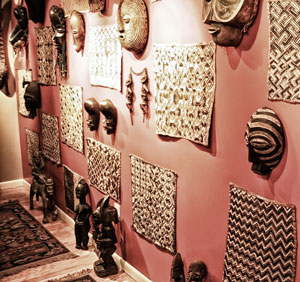 Ears vs. eyes.
Ears vs. eyes.
Here's something to chew on:
In February 2011, I was deep into Joseph Campbell's "Creative Mythology" -- how the European Middle Ages changed everything --seriously. In the Middle Ages people slowly began to break out of the claustrophobic expectations of the "village" -- and the arranged marriages that substituted for romantic love. People began demanding their own experiences, trusted their own experiences, trusted their own eyes to see what they wanted. And the troubador's songs all tell us that the experience of amor enters through the eyes, travelling directly to the heart. On the other hand, what enters through the portal of the ears travels directly to the brain... and those messages are all about how one maintains membership in the village, the rules for belonging. You know, do this, do that. The eyes want, the ears instruct.
In a stable, well-regulated society the eyes are free to wander outside the village gate and the heart opens to the mystery beyond the walls. Individualism and finding one's one path through the darkest part of the forest are the hero's adventure.
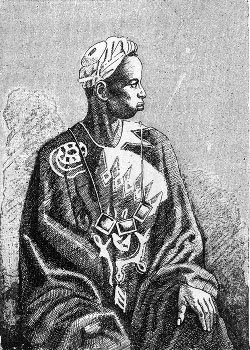 In a disrupted society -- those characterized by slavery, Jim Crow laws, violence exploding from poverty and continuing economic and familial woes -- perhaps belonging is what's important. Perhaps the words of the griot, the West African storyteller and historian -- today embodied in the MC -- are what is needed to hold the society together, to explain how far they've come, how much they have suffered, how intrinsically wise and powerful they are. To hold their people together.
In a disrupted society -- those characterized by slavery, Jim Crow laws, violence exploding from poverty and continuing economic and familial woes -- perhaps belonging is what's important. Perhaps the words of the griot, the West African storyteller and historian -- today embodied in the MC -- are what is needed to hold the society together, to explain how far they've come, how much they have suffered, how intrinsically wise and powerful they are. To hold their people together.
It is intriguing to consider this difference between eyes and ears in our emotional response to the various arts of African origins. Hear the beat. Keep in step. Learn the story. You are one of us. Or peek behind the curtain. Follow the disturbance. Believe your eyes. Let your heart guide the way out of the village and into the realm of mystery and romance.
Postscript... no science behind any of this eyes vs ears stuff, derived from old European legends... but it seems like a pleasant cocktail of ideas for a hot summer afternoon.
7.18.2013
